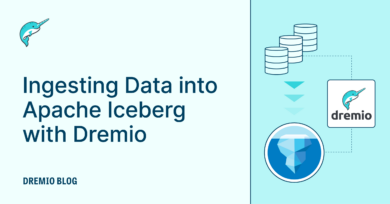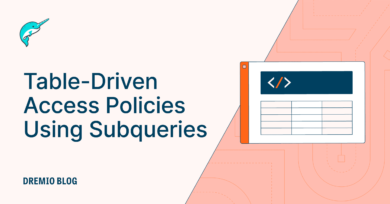12 minute read · September 18, 2025
Why Dremio is the Ideal Secure Data Platform for Transportation & Automotive Companies
· Head of DevRel, Dremio

Modern transportation and automotive companies are awash in data. A single connected car can generate up to 25 GB of data every hour as its sensors, telematics units and infotainment systems stream information about vehicle health, location, driver behaviour and passenger preferences. This torrent of data has become a competitive advantage: manufacturers and fleet operators use it to improve performance, reduce downtime, personalize services and power subscription‑based business models. Yet the same data also contains sensitive personal information – everything from precise geolocation and driver‑assist footage to biometric identifiers.
Regulators around the world have noticed. Laws such as the U.S. Driver Privacy Act (which asserts that the vehicle owner or lessee owns event‑data‑recorder information), state privacy laws like the CCPA/CPRA, and Europe’s GDPR and forthcoming Data Act all impose strict requirements on how automotive data can be collected, stored and shared. Industry‑specific guidelines from NHTSA and UN Regulation 155 demand secure software updates, vulnerability disclosure and “security by design”. Non‑compliance can lead to hefty fines, litigation and reputational damage.
To harness the value of connected‑vehicle data while remaining compliant, transportation and automotive firms need a unified data platform that can ingest diverse data sources, enforce fine‑grained access controls, provide complete auditability and scale to petabyte‑size telemetry streams. This blog explores why a modern lakehouse platform – and specifically Dremio – is uniquely suited to meet these challenges, offering an open architecture, high‑performance querying, and built‑in data governance features designed for the automotive industry’s complex regulatory landscape.
The Regulatory Landscape for Transportation & Automotive Data
Few industries sit at the crossroads of innovation and regulation quite like transportation and automotive. Automakers, fleet operators, and mobility providers not only manage enormous volumes of connected-vehicle data but must also navigate an evolving patchwork of privacy, cybersecurity, and safety requirements.
In the United States, federal rules like the Driver Privacy Act, Drivers Privacy Protection Act, and NHTSA cybersecurity guidelines dictate how vehicle data can be collected, accessed, and secured. State-level privacy laws such as the CCPA and CPRA add further layers, requiring transparency, user consent, and strict data-subject rights management. Trucking companies face FMCSA rules around electronic logging devices, including strict retention and auditing requirements.
Globally, regulations are even more complex. Europe enforces GDPR and is now rolling out the EU Data Act, which compels manufacturers to make vehicle-generated data portable and accessible to consumers and third parties. UN Regulations R155 and R156 mandate cybersecurity management systems and secure software-update practices for all new vehicles. Meanwhile, other jurisdictions, including China, are imposing data-localization and cross-border transfer restrictions.
For transportation and automotive companies, the takeaway is clear: compliance is not optional. The industry’s ability to monetize connected-vehicle data, enable predictive maintenance, or offer advanced mobility services depends on building platforms that are not only powerful and scalable but also deeply aligned with regulatory obligations. This is where modern data lakehouse platforms come into play.
Data Challenges for Transportation & Automotive Companies
While regulations set the boundaries, the practical realities of managing transportation and automotive data bring their own hurdles. Connected vehicles, logistics networks, and mobility platforms generate torrents of information that can overwhelm traditional data systems if not properly designed.
Try Dremio’s Interactive Demo
Explore this interactive demo and see how Dremio's Intelligent Lakehouse enables Agentic AI
Exploding Volumes and Variety
Modern cars, trucks, and buses are effectively rolling data centers. Every sensor, telematics unit, and onboard system contributes to a diverse stream of inputs, ranging from engine diagnostics and GPS coordinates to driver-assist video and infotainment usage. Fleet operators must combine this with external sources like supply-chain data, repair shop records, and customer interactions. The result is massive datasets with complex formats and schemas.
Data Silos and Integration Barriers
Automotive ecosystems are notoriously fragmented. Manufacturers, suppliers, dealers, insurers, and regulators all touch the same data but often store it in isolated systems. Integrating these silos for real-time insights, without creating redundant pipelines or data copies, remains a challenge. Each new integration can bring cost, latency, and governance concerns.
Compliance Burdens
With regulations emphasizing consent, retention, portability, and cybersecurity, automotive companies can no longer treat compliance as an afterthought. Every data access, transformation, and export must be auditable and aligned with global requirements. Without the right tools, ensuring fine-grained controls across distributed datasets is both expensive and error-prone.
Demand for Real-Time Insights
The industry’s use cases, predictive maintenance, over-the-air software updates, driver safety analysis, route optimization, and even monetizing vehicle data, require more than just storage. They demand low-latency analytics that can combine live telemetry with historical context. Traditional ETL pipelines, which batch process data and move it across systems, struggle to deliver at the speed the industry now requires.
What a Secure Automotive Data Platform Must Deliver
The intersection of massive data flows and strict regulatory oversight means transportation and automotive companies can’t rely on legacy data architectures. To thrive, they need platforms built with compliance, performance, and adaptability at their core. A secure automotive data platform should provide several critical capabilities:
Unified Data Access
Data comes from everywhere: telematics units, on-board diagnostics, infotainment systems, manufacturing ERP platforms, supplier databases, and even customer apps. A modern platform must connect these sources without duplicating or moving data unnecessarily. Unified access reduces costs, streamlines analytics, and makes it easier to apply governance policies consistently.
Fine-Grained Governance
With personal, sensitive, and safety-critical information flowing through the ecosystem, governance is non-negotiable. The platform must offer role-based controls along with row-level and column-level permissions to ensure that only authorized stakeholders can access specific details. This supports compliance with privacy regulations and minimizes exposure in the event of a breach.
End-to-End Visibility
Auditing and lineage capabilities are essential. Companies need to know where data originated, how it was transformed, and who accessed it. This transparency not only satisfies regulators but also builds trust with customers who increasingly want assurance that their data is handled responsibly.
Open and Interoperable Architecture
The EU Data Act and similar regulations emphasize portability and interoperability. To avoid vendor lock-in and meet data-sharing obligations, a secure platform should leverage open standards like Apache Iceberg and Apache Arrow. This ensures that data remains usable across partners, regulators, and new analytics tools that emerge in the future.
High Performance at Scale
Finally, the platform must keep up with the pace of the industry. Real-time applications like predictive maintenance, autonomous driving analytics, and fleet optimization depend on fast queries across petabyte-scale datasets. Intelligent workload management and built-in acceleration are critical for making real-time insights practical without runaway costs.
Why Dremio is the Ideal Solution
With the requirements of a secure automotive data platform established, the next question is: which solution can actually deliver on all these fronts? This is where Dremio’s open data lakehouse platform stands out. It is uniquely positioned to help transportation and automotive companies manage exploding data volumes, comply with global regulations, and still move fast enough to innovate.
Open, High-Performance Lakehouse
Dremio is built on open standards like Apache Iceberg and Apache Arrow, ensuring data remains portable and interoperable across tools, clouds, and partners. This aligns directly with global regulatory pushes, such as the EU Data Act, that emphasize data portability and interoperability. By avoiding vendor lock-in, automotive firms retain the flexibility to meet future compliance demands while supporting innovation.
At the same time, Dremio’s query engine delivers lightning-fast performance. Whether analyzing real-time telematics streams or multi-year warranty data, Dremio allows teams to run sub-second queries across petabyte-scale datasets without heavy ETL or data copies. This enables predictive maintenance, fleet optimization, and safety analytics to happen in real time.
Robust Data Governance and Security
Dremio embeds governance into every layer of the platform. Role-based access control (RBAC), row- and column-level permissions, and column masking ensure that sensitive driver information or proprietary design data is only visible to authorized users. Every query is audited, and full lineage is captured so compliance teams can prove data integrity and respond quickly to regulatory inquiries. These features make it much easier to satisfy requirements like GDPR’s “right of access” or FMCSA’s data retention obligations.
Multi-Cloud and Hybrid Flexibility
Automotive data doesn’t live in one place. It spans on-board systems, dealer systems, manufacturing plants, and cloud telematics services. Dremio is designed to unify all of these, whether the data is in AWS, Azure, GCP, or on-premises storage. Automotive firms can analyze data in place, without expensive and time-consuming data movement, unlocking a single, governed view across the ecosystem.
Business Benefits
The combination of open architecture, strong governance, and high performance directly translates into business value:
- Faster innovation: Quickly test new services like usage-based insurance or driver safety apps.
- Lower costs: Query data in place, reduce ETL pipelines, and avoid vendor lock-in.
- Regulatory confidence: Demonstrate compliance with privacy and cybersecurity mandates through governance, auditing, and lineage.
- Scalability: Easily scale from a few terabytes of data to petabyte-scale connected-vehicle streams without re-architecting.
Conclusion
The transportation and automotive industry sits at a unique inflection point: vehicles are now data platforms as much as they are machines. With each car, truck, or bus generating gigabytes of telemetry, location, and sensor data every hour, the potential for innovation is enormous. Yet the regulatory landscape, from U.S. privacy laws to EU mandates on data portability and global cybersecurity standards, makes it clear that this data must be handled with care. Non-compliance isn’t just a legal risk; it undermines consumer trust and can derail new business models before they gain traction.
Dremio offers the right balance of openness, governance, and performance to meet these challenges. Its foundation on open standards ensures compliance with emerging data-sharing rules, while its fine-grained access controls and auditing capabilities give companies confidence in their regulatory posture. At the same time, its high-performance query engine and federated access empower teams to unlock insights in real time, supporting predictive maintenance, safety analytics, fleet optimization, and new revenue streams.
For transportation and automotive companies, the path forward is clear: success will belong to those who can both harness and protect their data. By adopting Dremio as the backbone of a secure data platform, organizations can accelerate innovation, reduce costs, and stay firmly on the right side of evolving regulations.
See Dremio’s Intelligent Lakehouse Features First Hand by Signing up for a Workshop.


